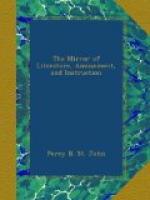“They swommin full of smale fishes
lighte,
With finnis rede, and scalis silver brighte.”
A single impression of his John Doree sold lately in London for ten guineas. And when they do come out, though every admirer will lament he was, long ere completion, called to his blessed account, their sorrow will be softened at beholding with what effect and spirit his animated graver has been caught up by his son.”
In the summer of 1828, Bewick visited London about his works. “He was,” says Mr. Dovaston, “very honourably received by many learned societies and individuals, of whom, and of whose collections, he wrote in raptures. On his return, the London and provincial papers had many paragraphs respecting this visit, his reception, and his life; to amend the errors of which statements, I must have been writing one at the very hour of his death; for I had not time to stop its insertion in one of the Shrewsbury papers, when I received a short, but most affectionate and affecting letter from his son, informing me, ‘as his father’s most valued friend,’ that he expired, in full possession of his fine and powerful mental faculties, in quiet and cheerful resignation, on the 8th of November, 1828, in the 76th year of his age. On the morning of his death he had the satisfaction of seeing the first proof-impression of a series of large wood-engravings he had undertaken, in a superior style, for the walls of farm-houses, inns, and cottages, with a view to abate cruelty, mitigate pain, and imbue the mind and heart with tenderness and humanity; and this he called his last legacy to suffering and insulted Nature.”
[1] The Mirror, it
will be remembered, was the first work of
its
class that presented this economical attraction to
the
public:
the Engravings throughout the Series number upwards
of
Eight Hundred.
[2] In the Museum at Newcastle,
are many of the identical
specimens
from which Bewick drew his figures for the
wood-cuts
of his zoological works.
[3] See a paper on “the
Life, Genius, and Personal Habits of
Bewick,”
in the Magazine of Natural History, vol. iii.;
by
his
friend, John F. Dovaston, Esq., A.M., of Westonfelton,
near
Shrewsbury. There is a vein of generous enthusiasm—a
glow
of friendship—a halo of the finest feelings
of our
nature—throughout
and around this memoir, which has the
sincerity
and singleness of heart of—A FRIEND.
[4] In Mr. Dovaston’s
paper is a misprint, which it may be as
well
to notice here. It is stated that Bewick cut the
Old
Exchange,
at Newcastle, (the vignette of the above volume) in
1719.
* * * * *
MANNERS AND CUSTOMS.
FUNERAL GARLANDS.




